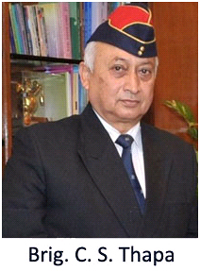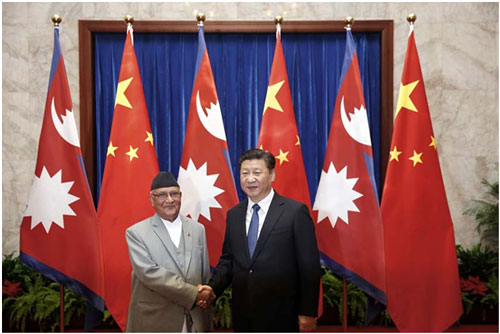 Two phase Nepal elections were held on 26 November and 07 December, respectively. Nepal’s federal structure consists of two houses, House of Representatives (HoR) Lower House, and National Assembly (N A) Upper House. Unlike India, the two houses have near equal powers.
Two phase Nepal elections were held on 26 November and 07 December, respectively. Nepal’s federal structure consists of two houses, House of Representatives (HoR) Lower House, and National Assembly (N A) Upper House. Unlike India, the two houses have near equal powers.
The current results clearly show a lead by the two Communist parties who came together to have an alliance. They have collectively won 174 seats out of 275 which is a majority of 63%. The Communist Party of Nepal (United Marxist- Leninist) has won 80 seats in the first past the post (FPTP) method and with a 33.25% vote share getting an additional 41 seats in the proportional representation (PR) system to make a grand tally of 121 seats and becoming the single largest party.
Their alliance partner Communist Party of Nepal (Maoist- Centre) has won 36 seats in the FPTP method but a vote share of only 13.66% to get another 17 seats in the PR method to tally at 53 seats. The Nepali Congress (NC), seen as a pro-India party, has come second although they have won just 23 seats in the FPTP method but have a huge vote share of 32.78% which is roughly half a percent less than the vote share the winner Marxist- Leninist thus have got 40 seats in the PR method and stand second with 63 seats.
The two communist parties, together, thus make 174 seats while the NC has only 63 seats. The other parties like the Rastriya Janata Party Nepal has a total of 11+6 (17) seats, Federal Socialist Forum 16, and five single seats to five parties. The scene is thus set for Mr Khadga Prasad (KP) Oli to take over once other formalities mentioned above are resolved. Oli fought the election mainly on an anti-India plank.

In the NA or Upper House out of 59 members, 56 are elected by Electoral College and three are appointed by the President. There is also a clash between the President Bidhya Devi Bhandari who is from the Communist background and the caretaker PM,
Sher Bahadur Deuba on formation of Upper House and it still remains an unresolved issue just as the issue regarding formation of the government and seven provinces are concerned. The common man in Kathmandu is yet to be convinced that the elections will bring stability and constitutional order because of unresolved issues.
The winning left alliance is definitely pro-China although they officially talk of being equidistant, to both India and China. Earlier whenever, the Nepalese have sought the Chinese help, their northern neighbour has told the Nepalese leadership to be patient and give the Chinese time. In the meanwhile the Chinese have built up their infrastructure and are now ready to give all out help to Nepal.
The infrastructure is the extension of the railway line from Lhasa to Shigatse. The next cause for concern is of course how will a pro Chinese leaning Oli react to the, One Belt One Road (OBOR) initiative which the Chinese would now like to extend to Nepal.
The political ramifications of such a massive win for the left parties wherein the pro India NC has been badly defeated are bound to be felt in New Delhi. For the left it is an overwhelming win having garnered 63 % seats on an anti-India stand. The blockade post the earthquake became a key turning point in the poll campaign.
However we must not forget that both Oli and Maoist leader Pushp Kamal Dahal Prachanda are strong personalities and power sharing will be a problem. The Madhesi demands on which India harked does have political and security mainly law and order issues with India. The other issues that India backs like discrimination has not died down but how will Nepal tackle these problems as they are the Achille’s Heel of the current Nepal-India relationship.
Will Nepal continue to hark on an anti-India stance, it really cannot because after some time people to people ties are so central and the relationship so strong and Nepal manpower flows to India and not Tibet that an anti-India stance will become counterproductive.
But one of the key decisions KP Oli is likely to take is reverse building the Budi Gandaki river hydro project to the Chinese Gezhouba Group, which was set aside by the Deuba government. China on the other hand is keen to connect Nepal with a railway line passing through Rasugarhi linking all the way up to Lumbini the place where Gautama Buddha was born.
The railway line and roads plus dams that China may construct in the near future will put Nepal firmly in China’s grip. The election manifesto of the left alliance states that, under the coalition’s government, the India-Nepal Peace and Friendship Treaty 1950 will be terminated and new treaty put in place.
Prithvi Narayan Shah who unified Nepal in the 18th century famously said, “Nepal is a yam between two boulders”. With Oli who is anti-India likely to come to power these prophetic words will be put to test more at Oli insistence, being pro-China, rather than India’s action.
For the last two hundred years India has maintained status quo with Nepal, but a look at China’s historical record shows a strong China as an assertive China. Historically, Tibet has remained a part of China’s integrated “peripheral policy” but never an integral part “China’s Tibet policy”.
The Sinicization of Tibet which means an unleashing of reforms and migration of large number of Han Chinese to make Tibet look like mainland China is for Nepal to see. The Chinese may support with a lot of economic might but the cost is a debt trap, and that is the balancing act Oli and company need to compare. Pakistan and closer by Sri Lanka are walking into the same.
India has deep cultural ties, people to people friendly relationship, it’s going to be more of a test for Nepal and on the other hand India will have to walk the extra mile to ensure its back to a more nuanced policy with Nepal. India has to ensure that geo strategically the mighty Himalayas remain a barrier; the military cost of a breach in the name of development will be very costly.
(The writer is an Indian Army veteran who has authored books Gorkha: In Search Of Identity and Gorkha: Society and Politics)